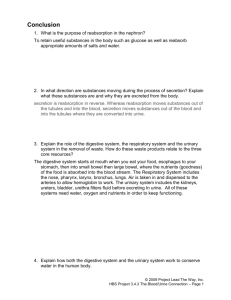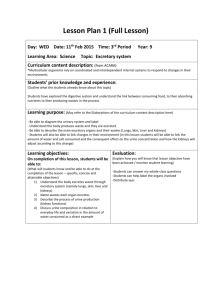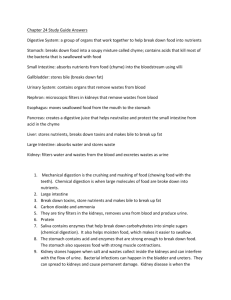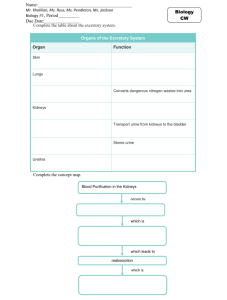Unit IV-C - Respiration and Excretion
advertisement
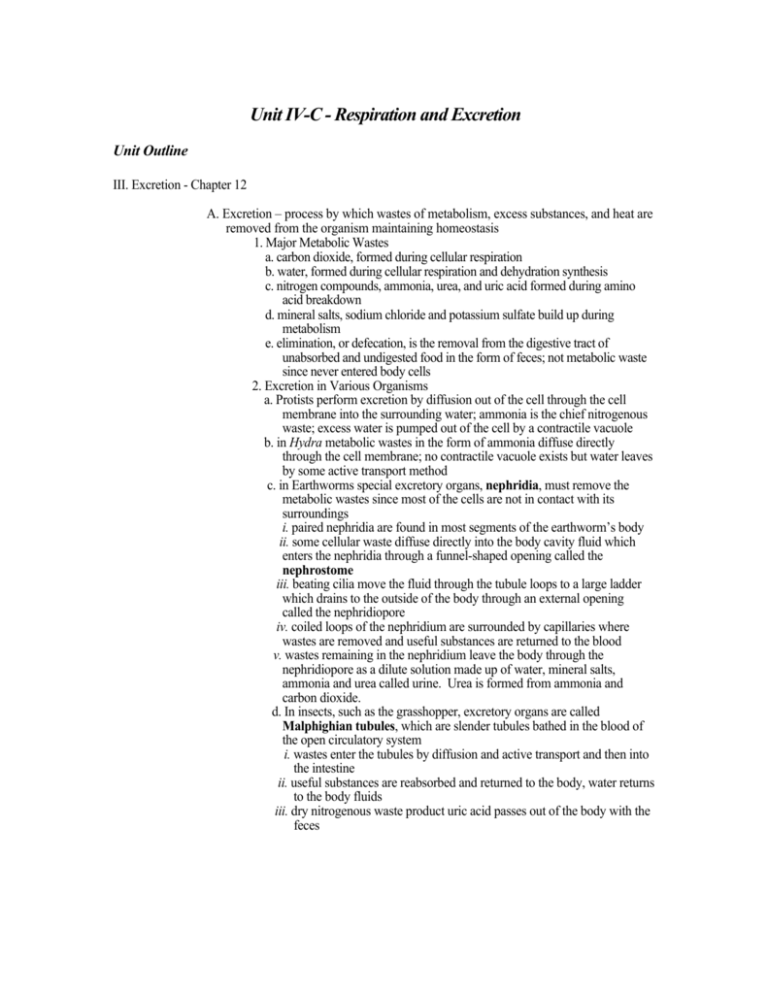
Unit IV-C - Respiration and Excretion Unit Outline III. Excretion - Chapter 12 A. Excretion – process by which wastes of metabolism, excess substances, and heat are removed from the organism maintaining homeostasis 1. Major Metabolic Wastes a. carbon dioxide, formed during cellular respiration b. water, formed during cellular respiration and dehydration synthesis c. nitrogen compounds, ammonia, urea, and uric acid formed during amino acid breakdown d. mineral salts, sodium chloride and potassium sulfate build up during metabolism e. elimination, or defecation, is the removal from the digestive tract of unabsorbed and undigested food in the form of feces; not metabolic waste since never entered body cells 2. Excretion in Various Organisms a. Protists perform excretion by diffusion out of the cell through the cell membrane into the surrounding water; ammonia is the chief nitrogenous waste; excess water is pumped out of the cell by a contractile vacuole b. in Hydra metabolic wastes in the form of ammonia diffuse directly through the cell membrane; no contractile vacuole exists but water leaves by some active transport method c. in Earthworms special excretory organs, nephridia, must remove the metabolic wastes since most of the cells are not in contact with its surroundings i. paired nephridia are found in most segments of the earthworm’s body ii. some cellular waste diffuse directly into the body cavity fluid which enters the nephridia through a funnel-shaped opening called the nephrostome iii. beating cilia move the fluid through the tubule loops to a large ladder which drains to the outside of the body through an external opening called the nephridiopore iv. coiled loops of the nephridium are surrounded by capillaries where wastes are removed and useful substances are returned to the blood v. wastes remaining in the nephridium leave the body through the nephridiopore as a dilute solution made up of water, mineral salts, ammonia and urea called urine. Urea is formed from ammonia and carbon dioxide. d. In insects, such as the grasshopper, excretory organs are called Malphighian tubules, which are slender tubules bathed in the blood of the open circulatory system i. wastes enter the tubules by diffusion and active transport and then into the intestine ii. useful substances are reabsorbed and returned to the body, water returns to the body fluids iii. dry nitrogenous waste product uric acid passes out of the body with the feces B. Human Excretory System 1. Liver a. detoxification – removes harmful substances, such as bacteria, certain drugs from the blood and changes them to less harmful forms, which are returned to the bloodstream and are excreted by the kidneys b. overloading with harmful materials leads to a disease called cirrhosis limiting the amount of purification c. bile, made by the liver, contains bile salts, cholesterol and part of the hemoglobin molecule from worn out red blood cells, collects in the gall bladder and is used in the emulsification of fats in the digestive process; bile salts are recycled, rest of the bile passes out of the body in the feces. When bile is not excreted properly, its metabolic wastes are reabsorbed resulting in jaundice where the skin appears to look yellow because of reabsorbed hemoglobin fragments in the blood. d. urea is formed from the breakdown products of amino acid metabolism: amino group is changed into ammonia the remainder of the amino acid molecule is changed into either pyruvic acid and used in respiration or is changed into glycogen or fat for storage; the ammonia is changed into urea returned to the blood and ultimately removed by the kidneys and excreted in the urine 2. Urinary System a. kidneys are bean-shaped organs about 10 centimeters long that lie against the muscles at the back in the abdomen just below the diaphragm. i. remove waste of cellular metabolism ii. regulate the concentrations of the substances found in the body fluids iii. three parts: cortex (blood is filtered), medulla (composed of collecting tubules), pelvis (cavity connected to ureter) iv. functional unit is the nephron of which there are c. 1.25 million per kidney a. glomerulus, a group of capillaries in a tight ball b. Bowman’s capsule, a double-walled cup-shaped structure into which substances are filtered from the blood in the glomerulus c. filtrate moves through the tubule, with some reabsorption occurring d. Blood circulation surround the kidney tubules v. urine made in two stages, filtration and reabsorption vi. filtration occurs in the glomeruli and Bowman’s capsules from blood under pressure; blood cells and blood proteins are too large to pass through and remain in the blood; c. 180 liters of filtrate are formed but only 1-1.5 liters of urine are produced in 24 hours vii. reabsorption reduces the volume of filtrate and returns various important substances to the blood – about 99% of the water (by osmosis), all of the glucose and amino acids, and many of the salts (by active transport), thereby concentrating the substances left and conserving water viii.most substances have a kidney threshold level, if the concentration of a substance in the blood is greater than a certain level, the excess substance is not reabsorbed and remains in the urine and is excreted from the body through the ureters to the bladder which is emptied through the urethra ix. sometimes substances crystallize out of urine – called kidney stones; second kidney can take over the work of the first; if both kidneys fail, fluid and wastes accumulate rapidly in the body; artificial kidney machines can be used in the process of dialysis to assist in waste removal 3. Lungs rid the body of carbon dioxide and water in the form of water vapor 4. Skin a. epidermis (outer layer) is formed of layers of tightly packed epithelial cells the deepest portion of which rapidly divides, pushing old cells upward from a source of nutrition eventually dying but not before producing a waterproofing protein called keratin which protects the underlying dermis b. dermis is made of elastic connective tissue, is full of blood vessels, lymph vessels, nerves, sense receptors, sebaceous glands (produce oily secretions that protect skin and hair), sweat glands (tiny coiled tubes that open to the surface of the skin through holes called pores), and hair follicles; a layer of fat or adipose tissue is beneath the dermis which varies in thickness depending on the overall weight of the individual c. functions i. keeps microorganisms and other foreign materials from entering the body ii. keeps the body from drying out iii. excretes a small amount of urea and salts in sweat which is 99% water iv. removal of excess heat by evaporation of sweat v. retention of body heat by reducing sweating and constriction of blood vessels





